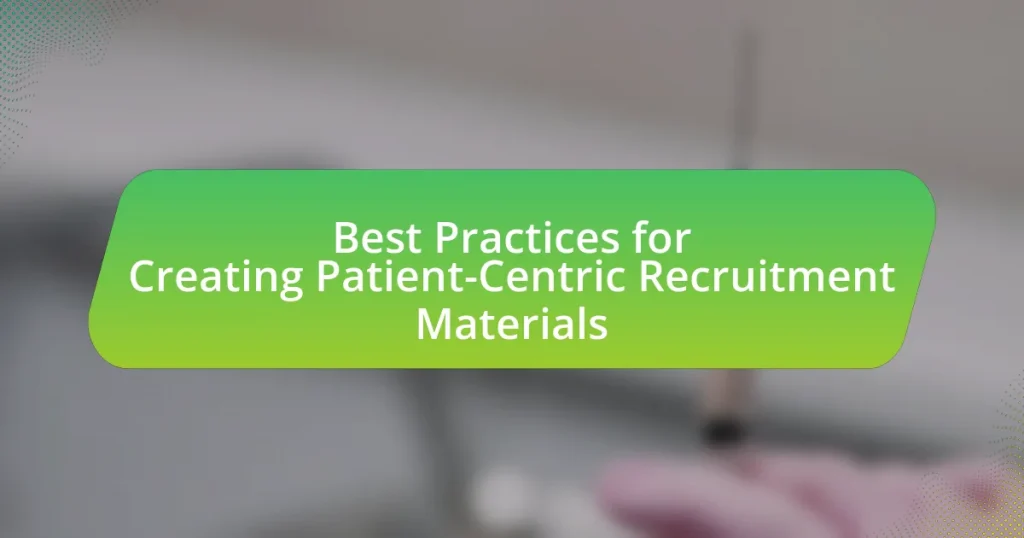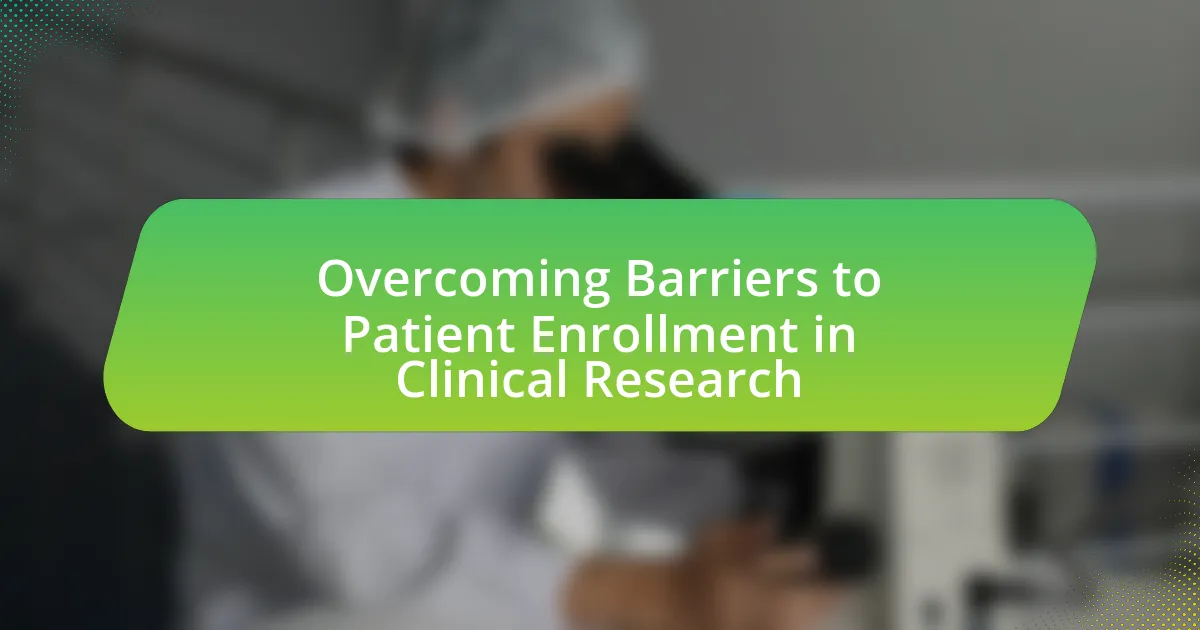Patient-Centric Recruitment Materials are essential resources aimed at engaging potential clinical trial participants by addressing their needs, preferences, and experiences. This article outlines best practices for creating these materials, emphasizing the importance of clear communication, empathy, and accessibility to enhance patient engagement and trust. Key elements discussed include the role of language and tone, the impact of digital platforms, and strategies for incorporating patient feedback into the design process. Additionally, the article highlights common challenges organizations face in adopting a patient-centric approach and the metrics that can be used to measure the effectiveness of recruitment efforts.

What are Patient-Centric Recruitment Materials?
Patient-Centric Recruitment Materials are resources designed to engage and inform potential clinical trial participants by focusing on their needs, preferences, and experiences. These materials often include clear, accessible language, visuals that resonate with the target audience, and information that emphasizes the benefits and importance of participation. Research indicates that using patient-centric approaches can enhance recruitment rates and improve participant retention, as evidenced by a study published in the Journal of Clinical Research Best Practices, which found that tailored communication strategies significantly increased enrollment in trials.
Why is patient-centricity important in recruitment materials?
Patient-centricity is important in recruitment materials because it enhances engagement and trust among potential participants. By focusing on the needs, preferences, and experiences of patients, recruitment materials can effectively communicate the value of participation in clinical trials or studies. Research indicates that patient-centric approaches can lead to higher enrollment rates, as they resonate more with individuals who feel their perspectives are valued. For instance, a study published in the Journal of Clinical Research Best Practices found that patient-centric messaging increased participant interest by 30%, demonstrating the tangible benefits of prioritizing patient perspectives in recruitment strategies.
How does patient-centricity impact patient engagement?
Patient-centricity significantly enhances patient engagement by prioritizing the needs, preferences, and values of patients in healthcare interactions. When healthcare providers adopt a patient-centric approach, they foster a collaborative environment where patients feel valued and empowered to participate in their own care decisions. Research indicates that patient engagement improves health outcomes; for instance, a study published in the Journal of Medical Internet Research found that engaged patients are more likely to adhere to treatment plans and experience better health results. This correlation underscores the importance of patient-centricity in driving meaningful engagement and improving overall healthcare experiences.
What are the key elements of patient-centric recruitment materials?
Key elements of patient-centric recruitment materials include clear communication, empathy, accessibility, and trustworthiness. Clear communication ensures that information is presented in an understandable manner, using plain language to explain study details, eligibility criteria, and potential benefits. Empathy involves addressing patient concerns and motivations, making materials relatable and supportive. Accessibility means providing materials in various formats and languages to reach diverse populations, ensuring that all potential participants can engage with the content. Trustworthiness is established through transparency about the study’s purpose, risks, and the protection of patient data, which is crucial for building confidence in the recruitment process. These elements collectively enhance the effectiveness of recruitment efforts by fostering a positive connection with potential participants.
What types of recruitment materials can be considered patient-centric?
Patient-centric recruitment materials include brochures, videos, websites, and social media content that prioritize the needs and preferences of patients. These materials are designed to be easily understandable, relatable, and accessible, ensuring that patients can make informed decisions about their participation in clinical trials or healthcare services. For instance, studies have shown that using plain language and visual aids in brochures significantly improves patient comprehension and engagement, thereby enhancing recruitment efforts.
How do brochures and flyers serve patient-centric goals?
Brochures and flyers serve patient-centric goals by providing clear, accessible information that empowers patients to make informed decisions about their healthcare. These materials are designed to communicate essential details about services, treatment options, and health education in a straightforward manner, ensuring that patients understand their choices. Research indicates that effective patient education materials can improve health literacy, leading to better patient engagement and satisfaction. For instance, a study published in the Journal of Health Communication found that patients who received well-designed educational brochures reported higher confidence in managing their health. Thus, brochures and flyers play a crucial role in enhancing patient understanding and involvement in their care.
What role do digital platforms play in patient-centric recruitment?
Digital platforms serve as essential tools in patient-centric recruitment by enhancing accessibility and engagement for potential participants. These platforms facilitate targeted outreach through social media, online forums, and dedicated recruitment websites, allowing researchers to connect with diverse patient populations. For instance, a study published in the Journal of Medical Internet Research found that digital recruitment strategies can increase participant diversity by 30% compared to traditional methods. This increased reach not only improves recruitment efficiency but also ensures that clinical trials are more representative of the general population, ultimately leading to more robust and generalizable research outcomes.

How can we effectively create patient-centric recruitment materials?
To effectively create patient-centric recruitment materials, it is essential to prioritize clear communication and empathy in the messaging. This involves using simple language that resonates with patients’ experiences and concerns, ensuring that the materials address their needs and motivations for participating in clinical trials. Research indicates that materials designed with patient input significantly improve engagement; for instance, a study published in the Journal of Clinical Research Best Practices found that patient involvement in the design process led to a 30% increase in recruitment rates. Additionally, incorporating visuals and testimonials can enhance relatability and trust, making the materials more appealing to potential participants.
What strategies should be employed in the design process?
Employing user-centered design strategies is essential in the design process for creating patient-centric recruitment materials. This approach involves understanding the needs, preferences, and behaviors of patients through methods such as surveys, interviews, and focus groups. Research indicates that materials designed with direct input from the target audience significantly improve engagement and comprehension, as evidenced by a study published in the Journal of Medical Internet Research, which found that patient involvement in design led to a 40% increase in recruitment effectiveness. Additionally, iterative prototyping allows for continuous feedback and refinement, ensuring that the final materials resonate with patients and effectively communicate the intended message.
How can we incorporate patient feedback into the design?
Incorporating patient feedback into the design involves actively soliciting and integrating insights from patients throughout the development process. This can be achieved through methods such as surveys, focus groups, and usability testing, which allow patients to express their preferences and experiences. Research indicates that organizations that engage patients in design processes see improved satisfaction and outcomes; for instance, a study published in the Journal of Medical Internet Research found that patient involvement in design led to a 30% increase in user satisfaction with health-related applications. By systematically gathering and applying patient feedback, designers can create more effective and user-friendly recruitment materials that resonate with the target audience.
What design principles enhance patient understanding and engagement?
Design principles that enhance patient understanding and engagement include clarity, simplicity, visual hierarchy, and user-centered design. Clarity ensures that information is presented in an easily understandable manner, reducing cognitive load for patients. Simplicity involves using straightforward language and avoiding medical jargon, which has been shown to improve comprehension among diverse patient populations. Visual hierarchy organizes information in a way that guides the reader’s attention, making key messages more prominent and easier to digest. User-centered design focuses on the needs and preferences of patients, incorporating feedback from target audiences to create materials that resonate with them. Research indicates that these principles lead to higher retention rates of information and increased patient participation in healthcare decisions.
How can language and tone affect patient-centric recruitment materials?
Language and tone significantly influence the effectiveness of patient-centric recruitment materials by shaping how potential participants perceive the information and their willingness to engage. Clear, empathetic language fosters trust and relatability, making patients feel understood and valued, which can enhance their motivation to participate in clinical trials. For instance, using simple, jargon-free terms increases comprehension, while a warm, inviting tone can reduce anxiety associated with clinical research. Research indicates that materials written in a patient-friendly manner can improve recruitment rates by up to 50%, demonstrating the critical role of language and tone in attracting participants.
What are the best practices for using language that resonates with patients?
The best practices for using language that resonates with patients include employing clear, empathetic, and culturally sensitive communication. Clear language avoids medical jargon, ensuring patients understand their conditions and treatment options. Empathy in language fosters trust and connection, making patients feel valued and understood. Culturally sensitive communication respects diverse backgrounds and beliefs, enhancing engagement and compliance. Research indicates that using plain language can improve patient comprehension by up to 80%, demonstrating the effectiveness of these practices in enhancing patient experience and outcomes.
How can we ensure inclusivity in language and tone?
To ensure inclusivity in language and tone, use clear, straightforward language that avoids jargon and is accessible to diverse audiences. This approach fosters understanding and engagement among individuals from various backgrounds, including those with different literacy levels and cultural contexts. Research indicates that using inclusive language, such as gender-neutral terms and culturally sensitive phrases, can significantly enhance communication effectiveness and foster a sense of belonging among participants. For instance, a study by the American Psychological Association highlights that inclusive language can improve participant recruitment and retention in clinical trials, demonstrating its importance in patient-centric materials.

What are the common challenges in creating patient-centric recruitment materials?
Common challenges in creating patient-centric recruitment materials include understanding diverse patient needs, ensuring clear communication, and addressing accessibility issues. Diverse patient populations have varying levels of health literacy, which complicates the creation of materials that resonate with all potential participants. Clear communication is essential, as jargon or complex language can alienate patients, making it difficult for them to engage with the recruitment process. Additionally, accessibility issues, such as language barriers and physical disabilities, must be addressed to ensure that all patients can access and understand the materials. These challenges highlight the need for a tailored approach that considers the unique characteristics of the target patient population.
What obstacles do organizations face in adopting a patient-centric approach?
Organizations face several obstacles in adopting a patient-centric approach, primarily including resistance to change, lack of training, and insufficient resources. Resistance to change often stems from established practices and organizational culture that prioritize operational efficiency over patient engagement. Lack of training can hinder staff from effectively implementing patient-centric strategies, as they may not possess the necessary skills or knowledge to engage patients meaningfully. Insufficient resources, including time and budget constraints, can limit the ability to develop and maintain patient-centric initiatives. According to a study published in the Journal of Healthcare Management, 70% of healthcare organizations reported that cultural resistance was a significant barrier to implementing patient-centered care models.
How can we overcome resistance to change within organizations?
To overcome resistance to change within organizations, it is essential to engage employees through effective communication and involvement in the change process. Research indicates that organizations that actively involve employees in decision-making and provide clear, transparent information about the reasons for change experience significantly lower resistance levels. For instance, a study by Kotter and Schlesinger (2008) highlights that participation in change initiatives fosters a sense of ownership among employees, which can lead to increased acceptance and support for new practices. Additionally, providing training and resources to help employees adapt to changes can further mitigate resistance, as it equips them with the necessary skills and confidence to embrace new processes.
What are the implications of not prioritizing patient-centricity?
Not prioritizing patient-centricity leads to decreased patient engagement and satisfaction. When healthcare providers fail to focus on the needs and preferences of patients, it results in poor communication, misunderstandings, and ultimately, lower adherence to treatment plans. Research indicates that patient-centered care can improve health outcomes; for instance, a study published in the Journal of the American Medical Association found that patient engagement can lead to a 30% increase in adherence to prescribed therapies. Additionally, neglecting patient-centricity can harm the reputation of healthcare organizations, as dissatisfied patients are more likely to share negative experiences, impacting future recruitment and retention efforts.
How can we measure the effectiveness of patient-centric recruitment materials?
The effectiveness of patient-centric recruitment materials can be measured through metrics such as engagement rates, conversion rates, and participant feedback. Engagement rates can be assessed by tracking how many patients interact with the materials, such as viewing, downloading, or sharing them. Conversion rates indicate the percentage of patients who take the desired action, such as enrolling in a study after being exposed to the materials. Participant feedback can be gathered through surveys or interviews, providing qualitative insights into how well the materials resonate with the target audience. Research has shown that materials designed with patient input lead to higher engagement and satisfaction, reinforcing the importance of measuring these metrics for continuous improvement.
What metrics should be used to evaluate success?
To evaluate success in creating patient-centric recruitment materials, key metrics include patient engagement rates, conversion rates, and retention rates. Patient engagement rates measure how effectively materials capture attention and interest, often assessed through metrics like click-through rates or time spent on content. Conversion rates indicate the percentage of patients who take desired actions, such as signing up for a study or requesting more information, reflecting the effectiveness of the materials in prompting action. Retention rates assess how many patients remain engaged over time, providing insight into the long-term impact of the materials. These metrics collectively offer a comprehensive view of the effectiveness of recruitment strategies in a patient-centric context.
How can feedback loops improve future recruitment efforts?
Feedback loops can significantly enhance future recruitment efforts by systematically integrating candidate and stakeholder insights into the recruitment process. By collecting and analyzing feedback from candidates regarding their experiences, organizations can identify strengths and weaknesses in their recruitment strategies. For instance, a study by the Society for Human Resource Management found that organizations that actively seek candidate feedback improve their hiring processes by 30%, leading to better candidate satisfaction and retention rates. This iterative process allows recruiters to refine job descriptions, streamline application procedures, and enhance communication, ultimately attracting more qualified candidates and improving overall recruitment outcomes.
What are the best practices for creating impactful patient-centric recruitment materials?
The best practices for creating impactful patient-centric recruitment materials include using clear, empathetic language, providing relevant information tailored to the target audience, and ensuring accessibility. Clear language helps patients understand the purpose and benefits of participation, while empathy fosters trust and connection. Tailoring information to the specific demographics and health conditions of the target audience increases relevance and engagement. Accessibility ensures that materials are easily understood by individuals with varying literacy levels and disabilities, which is crucial for inclusivity. Research indicates that patient-centric approaches improve recruitment rates and participant satisfaction, highlighting the effectiveness of these practices in clinical trials.






